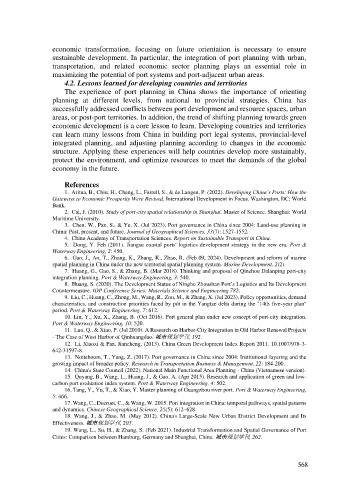Page 576 - Ebook HTKH 2024
P. 576
economic transformation, focusing on future orientation is necessary to ensure
sustainable development. In particular, the integration of port planning with urban,
transportation, and related economic sector planning plays an essential role in
maximizing the potential of port systems and port-adjacent urban areas.
4.2. Lessons learned for developing countries and territories
The experience of port planning in China shows the importance of orienting
planning at different levels, from national to provincial strategies. China has
successfully addressed conflicts between port development and resource spaces, urban
areas, or post-port territories. In addition, the trend of shifting planning towards green
economic development is a core lesson to learn. Developing countries and territories
can learn many lessons from China in building port legal systems, provincial-level
integrated planning, and adjusting planning according to changes in the economic
structure. Applying these experiences will help countries develop more sustainably,
protect the environment, and optimize resources to meet the demands of the global
economy in the future.
References
1. Aritua, B., Chiu, H., Cheng, L., Farrell, S., & de Langen, P. (2022). Developing China’s Ports: How the
Gateways to Economic Prosperity Were Revived. International Development in Focus. Washington, DC: World
Bank.
2. Cai, J. (2010). Study of port-city spatial relationship in Shanghai. Master of Science. Shanghai: World
Maritime University.
3. Chen, W., Pan, S., & Ye, X. (Jul 2023). Port governance in China since 2004: Land-use planning in
China: Past, present, and future. Journal of Geographical Sciences, 33(7): 1527-1552.
4. China Academy of Transportation Sciences. Report on Sustainable Transport in China.
5. Dong, Y. Feb (2011). Jiangsu coastal ports′ logistics development strategy in the new era. Port &
Waterway Engineering, 2: 450.
6. Gao, J., An, T., Zhang, K., Zhang, K., Zhao, R. (Feb 09, 2024). Development and reform of marine
spatial planning in China under the new territorial spatial planning system. Marine Development, 2(2).
7. Huang, G., Gao, S., & Zhang, B. (Mar 2018). Thinking and proposal of Qinzhou Dalanping port-city
integration planning. Port & Waterway Engineering, 3: 540.
8. Huang, S. (2020). The Development Status of Ningbo Zhoushan Port’s Logistics and Its Development
Countermeasure. IOP Conference Series: Materials Science and Engineering 782.
9. Liu, C., Huang, C., Zhong, M., Wang, R., Zou, M., & Zhang, X. (Jul 2023). Policy opportunities, demand
characteristics, and construction priorities faced by pót in the Yangtze delta during the "14th five-year plan"
period. Port & Waterway Engineering, 7: 612.
10. Liu, Y., Xu, X., Zhang, B. (Oct 2016). Port general plan under new concept of port-city integration.
Port & Waterway Engineering, 10: 520.
11. Luo, Q., & Xiao, P. (Jul 2010). A Research on Harbor-City Integration in Old Harbor Renewal Projects
- The Case of West Harbor of Qinhuangdao. 城市规划学刊 , 192.
12. Li, Xiaoxi & Pan, Jiancheng. (2013). China Green Development Index Report 2011. 10.1007/978-3-
642-31597-8.
13. Notteboom, T., Yang, Z. (2017). Port governance in China since 2004: Institutional layering and the
growing impact of broader policy. Research in Transportation Business & Management, 22: 184-200.
14. China's State Council (2022). National Main Functional Area Planning - China (Vietnamese version).
15. Quyang, B., Wang, L., Huang, J., & Gao, A. (Apr 2015). Research and application of green and low-
carbon port evaluation index system. Port & Waterway Engineering, 4: 502.
16. Tang, Y., Yu, T., & Xiao, Y. Master planning of Guangzhou river port. Port & Waterway Engineering,
5: 466.
17. Wang, C., Ducruet, C., & Wang, W. 2015. Port integration in China: temporal pathways, spatial patterns
and dynamics. Chinese Geographical Science, 25(5): 612–628.
18. Wang, J., & Zhao, M. (May 2012). China's Large-Scale New Urban District Development and Its
Effectiveness. 城市规划学刊 , 203.
19. Wang, L., Su, H., & Zhang, S. (Feb 2021). Industrial Transformation and Spatial Governance of Port
Cities: Comparison between Hamburg, Germany and Shanghai, China. 城市规划学刊 , 262.
568

